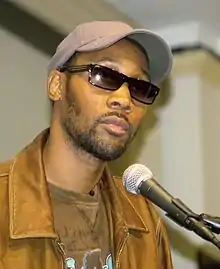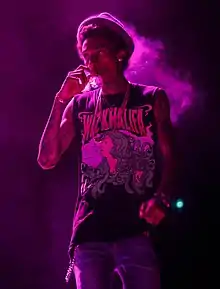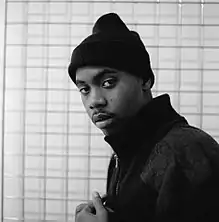East Coast hip hop
East Coast hip hop is a regional subgenre of hip hop music that originated in New York City during the 1970s.[2][3] Hip hop is recognized to have originated and evolved first in the Bronx, New York City.[4]
| East Coast hip hop | |
|---|---|
| Stylistic origins | |
| Cultural origins | Early to mid-1970s, The Bronx, New York City, New York, U.S.[1] |
| Fusion genres | |
| |
| Local scenes | |
| |
| Other topics | |
| |
In contrast to other styles, East Coast hip hop music has prioritized complex lyrics for attentive listening rather than beats for dancing.[4] The term "East Coast hip hop" more specifically denotes hip hop originating from the East Coast of the Northeastern United States; Southeastern states such as Georgia instead fall under the umbrella of Southern hip hop rather than "East Coast hip hop". A notable exception is the Hampton Roads music scene, centered on Virginia Beach, which produced artists as diverse as Missy Elliott, Pharrell and the Neptunes, Timbaland and the Clipse, all of whom are closely associated with the New York music scene and the evolution of East Coast hip hop, particularly from the late 1990s to present.[5][6][7]
Musical style
In contrast to the simplistic rhyme pattern and scheme utilized in old school hip hop, East Coast hip hop has been noted for its emphasis on lyrical dexterity.[2] It has also been characterized by multi-syllabic rhymes, complex wordplay, a continuous free-flowing delivery and intricate metaphors.[2] Although East Coast hip hop can vary in sound and style, "aggressive" beats and the combining of samples were common to the subgenre in the mid- to late 1980s.[4] The aggressive and hard-hitting beats of the form were emphasized by such acts as EPMD, Beastie Boys and Public Enemy, while artists such as Eric B. & Rakim, Boogie Down Productions, Big Daddy Kane, Nas, Notorious B.I.G and Slick Rick were noted for their lyrical skill. Lyrical themes throughout the history of East Coast hip hop have ranged from lyrical consciousness by such artists as Public Enemy and A Tribe Called Quest to Mafioso rap themes by rappers such as Raekwon, MF Grimm and Kool G Rap.[2]
History
Emergence (1970s–80s)
East Coast hip hop is occasionally referred to as New York rap due to its origins and development at block parties thrown in New York City during the 1970s.[2] According to AllMusic, "At the dawn of the hip-hop era, all rap was East Coast rap."[4] Leading up to hip hop, there were spoken-word artists such as the Last Poets who released their debut album in 1970, and Gil Scott-Heron, who gained a wide audience with his 1971 track "The Revolution Will Not Be Televised". These artists combined spoken word and music to create a kind of "proto-rap" vibe.[8] Following this, early artists of hip hop such as DJ Kool Herc, Grandmaster Flash, Afrika Bambaataa, the Sugarhill Gang, Kurtis Blow, Jam Master Jay and Run-DMC, pioneered East Coast hip hop during hip hop's earlier years in the 1970s and 1980s.[4] As the genre developed, lyrical themes evolved through the work of East Coast artists such as the Native Tongues, a collective of hip hop artists associated with generally positive, Afrocentric themes, and assembled by Afrika Bambaataa. New York-based groups such as De La Soul, A Tribe Called Quest and the Jungle Brothers also earned recognition for their musical eclecticism.[4]
Renaissance (1990s)

This was called "The Golden Age" of hip hop.[9] Although East Coast hip hop was more popular throughout the late 1980s, N.W.A's Straight Outta Compton (released in the summer of 1988) presented the toughened sound of West Coast hip hop, which was accompanied by gritty, street-level subject matter.[4] Later in 1992, Dr. Dre's G-funk record The Chronic would introduce West Coast hip hop to the mainstream. Along with a combined ability to keep its primary function as party music, the West Coast form of hip hop became a dominant force during the early 1990s.[4] Although G-Funk was the most popular variety of hip hop during the early 1990s, the East Coast hip hop scene remained an integral part of the music industry. During this period, several New York City rappers rising from the local underground scene, began releasing noteworthy albums in the early and mid-'90's, such as Nas, The Notorious B.I.G. and others.[10] The Stretch Armstrong and Bobbito Show was the launch pad for many East Coast rappers during this era.
Nas's 1994 debut album Illmatic has also been noted as one of the creative high points of the East Coast hip hop scene, and featured production from such renowned New York-based producers as Large Professor, Pete Rock and DJ Premier.[10] Meanwhile, The Wu-Tang Clan, Onyx, Black Moon, Smif-N-Wessun, Big L, Lost Boyz and Mobb Deep became pillars in New York's hardcore hip hop scene, achieving widespread critical acclaim for their landmark albums, Enter the Wu-Tang (36 Chambers) (1993), Lifestylez ov da Poor & Dangerous (1995), Enta da Stage (1993), Bacdafucup (1993), Dah Shinin' (1995), Legal Drug Money (1996) and The Infamous (1995).
The Notorious B.I.G. became the central figure in East Coast hip hop during most of the 1990s. Bad Boy Records comprised a team of producers known as the Hitmen Stevie J, Derrick "D Dot" Angelletie and Amen Ra directed by Sean Combs to move the focus on hip hop to New York with the Notorious B.I.G.'s Billboard topping hits.[11] His success on the music charts and rise to the mainstream drew more attention to New York at the time of West Coast hip hop's dominance.[11] According to AllMusic editor Steve Huey, the success of his 1994 debut album Ready to Die "reinvented East Coast rap for the gangsta age" and "turned the Notorious B.I.G. into a hip-hop sensation — the first major star the East Coast had produced since the rise of Dr. Dre's West Coast G-funk".[11] Many saw his dominating presence as a catalyzing factor in the East Coast/ West Coast hip hop rivalry that polarized much of the hip hop community, stirring the issue enough to result in the Brooklyn rapper's 1997 death, as well as his West Coast counterpart, Tupac Shakur, months prior.[12] His commercial success helped pave the way for the success of other East Coast rappers such as Jay-Z, DMX, Busta Rhymes, Ja Rule, The Lox, Fat Joe, Big Pun and many upcoming rappers.[11][13]
Mainstream decline (2000–2010)
Mainstream hip hop began to commercialize styles of Southern hip hop over traditional East and West Coast hip hop in the early 2000s, leading many critics and rappers, such as Nas, to proclaim that hip hop was 'dead' by the mid-2000s (although Nas claimed 15 years later that he was only referring to New York).[14] Southern hip hop artists such as Lil Wayne and T.I. gained prominence, with regional scenes in New Orleans and Atlanta. Other southern cities such as Houston and Miami received attention in the mainstream, with subgenres such as Houston's chopped and screwed hip hop, bounce and trap attracting commerical recognition.[15] Yet, despite this overall trend, individual East Coast hip hop artists did see significant success in the first decade of the 2000s, such as 50 Cent, Ja Rule, Fabolous, Cam'Ron, Lloyd Banks, Juelz Santana, Jim Jones and Talib Kweli. Jay-Z's seven studio albums and three collaborative albums released between 2000 and 2010 were all certified platinum, and nine out of ten reached #1 on US charts.[16]
Partial revival and the rise of New York drill (2010–present)

A partial mainstream revival of East Coast rap has occurred in the last decade, albeit without the same level of commercial success as in the nineties, due to various factors, such as the rise of social media, music streaming and the internet, which has led to a decline in unique regional scenes across many musical genres. In addition, rivalries between different cities and regions have declined significantly and artists across different regions and genres are much more willing to collaborate than in the past. Despite this, the distinctive East Coast sound is still notable in today's music. Major artists who have risen to prominence in the past decade include A$AP Mob particularly, A$AP Rocky and A$AP Ferg, Joey Bada$, Vast Aire, Azealia Banks, as well as French Montana, and most notably Nicki Minaj, Cardi B and J.Cole (himself a transplant from North Carolina), all based in New York City. Other notable artists include Wiz Khalifa, Meek Mill, and Lil Uzi Vert from Pennsylvania, Fetty Wap from New Jersey, and Wale and Logic from Washington, DC.
In addition, New York City's drill movement, heavily influenced by UK drill (and often using the same London producers), has injected new energy into the New York hip hop scene, attracting critical acclaim, media controversy and a significant following, despite departing from standard hip hop song structures. Initially focused in Brooklyn, led by artists such as the late Pop Smoke, Fivio Foreign, Sheff G, Sleepy Hallow, Bizzy Banks, J.I. Prince of N.Y., Jay Critch and others; and more recently in the Bronx, with artists such as A Boogie wit da Hoodie, Lil Tjay, Kay Flock, B Lovee, among others.[17]
Legacy
.jpg.webp)
East Coast hip hop was the dominant form of rap music during the Golden Era of hip hop.[2] Many knowledgeable hip hop fans and critics are particularly favorable of East Coast hip hop in the early and mid nineties, viewing it as a time of creative growth and influential recordings, and describing it as "The East Coast Renaissance". Music writer May Blaize of MVRemix Urban comments on the nostalgia felt among hip hop fans for records released during this time:
It was claimed as the East Coast Renaissance. Wu-Tang brought the ruckus with 36 Chambers. The world was ours when Nas released Illmatic. Big L, (The MVP) came out with Lifestylez ov da Poor and Dangerous. Temperatures rose in clubs when Mobb Deep came out with The Infamous and Brooklyn’s finest Jay-Z released Reasonable Doubt. . . And who can forget the powerful uplifting anthem that would brand New York’s concrete "Bucktown" (Smif-n-Wessun's hit single)? . . .Ahh, it was a beautiful time in hip-hop history that many of us wish we could return to.[18]
David Drake of Stylus Magazine writes of hip hop during 1994 and its contributions, stating: "The beats were hot, the rhymes were hot – it really was an amazing time for hip-hop and music in general. This was the critical point for the East Coast, a time when rappers from the New York area were releasing bucketloads of thrilling work – Digable Planets, Gang Starr, Pete Rock, Jeru, O.C., Organized Konfusion – I mean, this was a year of serious music."[10]
East Coast hip hop has also produced a multitude of highly acclaimed female rappers, including Salt and Pepa who have won one Grammy award, three MTV Video Music Awards, one Soul Train award, and two VH1 hip hop honors,[19] Queen Latifah who has won one Grammy award, one Soul Train Music award, and numerous acting awards,[20] Lil Kim who has one four ASCAP Rhythm & Soul Awards, six BDB Spin Awards, one Billboard Music Award, one New York Music award, four VH1 awards, and has been awarded the key to West Hollywood,[21] and Lauryn Hill who has won over one hundred musical awards and numerous international recognitions, having broken the record for most awards won by a female artist in a single Grammy ceremony and still holds the record for most nominations by a female artist in a single ceremony.[22] Other notable East Coast female rappers include Ladybug Mecca, Lisa "Left Eye" Lopes, Foxy Brown, Charli Baltimore, Missy Elliott, Eve, Angie Martinez, Remy Ma, Lil Mama, Nicki Minaj, and Cardi B, who have all left their impact on the legacy of hip hop.
See also
- Music of New York City
- Culture of New York City
- Music of New Jersey
- Music of Philadelphia
- Music of Baltimore
- Music of Massachusetts
- Music of Delaware
- Music of Washington, D.C.
- Music of Rhode Island
- East Coast–West Coast hip hop rivalry
- List of East Coast hip hop record labels
- Stretch and Bobbito: Radio That Changed Lives
References
- Ruth Blatt (April 10, 2014). "Why Rap Creates Entrepreneurs". Forbes. Retrieved November 25, 2019.
- Adaso, Henry. What Is East Coast Hip-Hop. About.com. Retrieved on March 1, 2009.
- Birke, Sarah. "Rack Attack: Observations on Hip-Hop". New Statesman America. Progressive Digital Media. Archived from the original on December 1, 2008. Retrieved January 8, 2019.
- Genre: East Coast Rap. AllMusic. Retrieved on March 1, 2009.
- "Hampton Roads Hip Hop History". May 28, 2021.
- "In Search of Chad Hugo". May 12, 2022.
- "Today In Hip-Hop History: The Clipse Release Their Debut LP 'Lord Willin' 19 Years Ago". August 20, 2021.
- "Jalal Mansur Nuriddin: farewell to the 'grandfather of rap'", The Guardian, 6 June 2018. Retrieved December 7, 2018.
- "The Best East Coast Rappers of All Time". Ranker. Retrieved December 18, 2017.
- Gloden, Gabe. I Love 1994. Stylus Magazine. July 21, 2004. Retrieved on 2015-06-21.
- Huey, Steve (September 26, 2003). Biography: The Notorious B.I.G.. Allmusic. Retrieved on February 10, 2011.
- Smith, RJ (March 18, 1997). "Murder Was the Case: Notorious B.I.G. Shot Down at 24—To Live and Die in L.A.". The Village Voice.
- Huey, Steve (September 26, 2003). Review: Ready to Die. Allmusic. Retrieved on February 10, 2011.
- "Nas Clarifies 'Hip Hop Is Dead' Album Was 'Mainly' Directed at NYC Rappers". Complex. December 23, 2021. Retrieved February 14, 2022.
- "The South Is Rap's Past, Present And Future". NPR. August 3, 2020. Retrieved February 14, 2022.
- "Jay-Z albums discography".
- "Pop Smoke, 'Welcome To The Party' Rapper, Dead At 20". NPR. February 19, 2020. Retrieved February 14, 2022.
- Blaize, May. THE PAST, THE PRESENT, THE ALBUM. MVRemix Urban. Retrieved on 2013-04-10.
- "Salt-N-Pepa Awards and Nominations".
- "List of awards and nominations received by Queen Latifah".
- "List of awards and nominations received by Lil' Kim".
- "List of awards and nominations received by Lauryn Hill".
External links
- Can't Stop, Won't Stop: A History of the Hip-Hop Generation — By Jeff Chang
- It's Bigger Than Hip Hop — By M. K. Asante, Jr.
- Rap Music and Street Consciousness — By Cheryl L. Keyes
